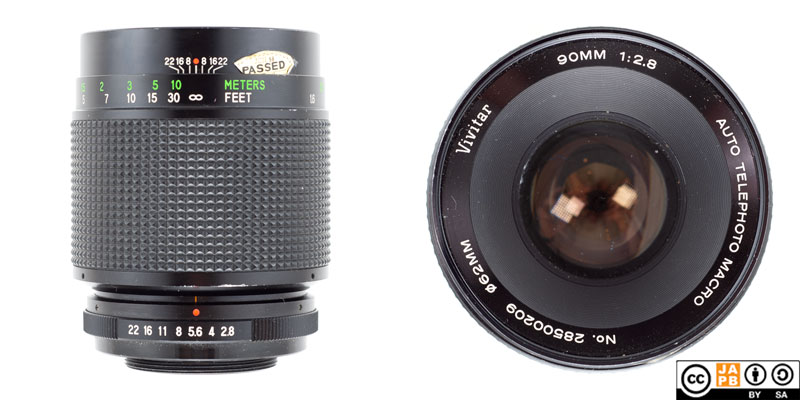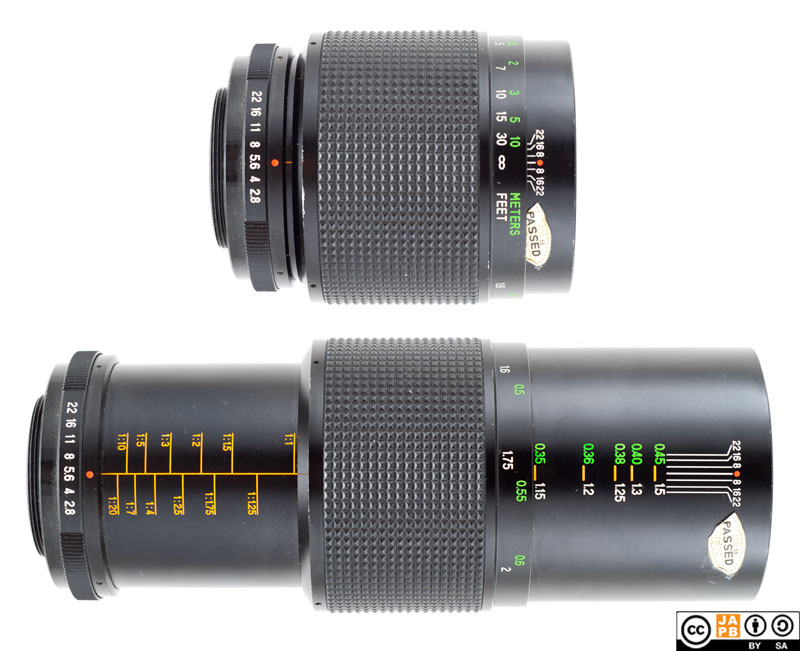Pekka Buttler, 11/2024

Specifications
The table below summarizes the lens’ key specifications (measurements based on pictured, last version of the lens):
| Brand: | Vivitar | Lens name | 90mm 1:2.8 auto telephoto macro |
| Focal length(s)1 | 90 mm | Angle-of-view2 | 27 ° |
| Maximum Aperture | f/2.8 | In Production | unclear3 |
| Lens mount (this lens) | M42 | Other lens mounts | multiple4 |
| Length5 | 70,4 mm | Diameter6 | 84,9 mm |
| Filter ring diameter | 55 mm | Weight | 479 grams |
| Lens element count | 6 | Lens group count | 4 |
| Aperture blades (S/R/C)7 | 8 S | Focus throw | 1000 ° |
| Minimum focusing distance | 35 cms | Maximum magnification | 1:1 |
| Has manual aperture ring | YES | Has Manual focus ring | YES |
| Aperture mechanism type | Auto | Aperture click stops 8 | 2.8•4•5.6•8•11•16-22 |
Further notes:
• This lens is an abnormal legacy macro lens in that it reaches 1:1 magnification without using an extension ring to reach beyond 1:2.
• It achieves this 1:1 maximum magnification using a rather extreme extension facilitated by a two-sided helicoid, driven by a focus throw that (at 2,75 revolutions) is almost absurd. While the focus throw does facilitate very precise fine-tuning of focus, changing focus between macro range and portrait range leads to an almost Dervish’s dance.
• The lens was originally manufactured by Komine.
• There are other similar era lenses that feature the same specifications (90 mm f/2.8, 1:1 macro with two-sided helicoid) sold under the names of other obvious rebranders (e.g. Panagor Auto Macro 90 mm f/2.8; Elicar V-HQ Macro 90 mm f/2.8) that might be related designs.

Bottom: Vivitar 90 mm f/2.8 Macro focused at MFD
The two-sided focusing helicoid is clearly apparent.
Versions and variations
Nothing points to there being more than one Vivitar 90 mm f/2.8 macro lens, albeit that lens was manufactured in several different mounts (and thus in somewhat differing dimensions and weights). One online source that says this lens to be a 6 elements in 6 groups design with 5 aperture blades can be deemed to simply be in error.
However, there may be some confusion as this was not the only tele macro lens offered by Vivitar during the roughly same era
Besides this (Komine made) 90 m f/2.8 macro, Vivitar also sold a Series 1 90 mm f/2.5 Macro which in turn was manufactured by Tokina and is basically a copy of Tokina’s famous 90 mm f/2.5 ‘Bokina’ [data sheet]. There was also a Vivitar 100 mm f/2.8 Macro that was manufactured by Kino Precision (Kiron).
History of Vivitar
Vivitar initially was the trade name used by Ponder & Best Inc. until Ponder & Best changed its name to Vivitar Corp. From the 1960s to the early 2000s the company contracted various (mostly Japanese) optical and electronics manufacturers to manufacture photographic gear to be branded as Vivitar.
You can read more details in the Vivitar company profile.
Adapting
n.B! The following applies to all M42 mount lenses.
This lens cannot be used natively on any current SLR or dSLRs. To use it in its native environment, you will need an M42-mount film body. Luckily there are a lot of those still available. When doing macro photography on a Film SLR, remain mindful of effective aperture.
Thanks to being a fully manual lens (manual aperture, manual focus), the lens can be adapted to all mirrorless cameras using a suitable adapter. Moreover, M42 lenses are so uncomplicated that a simple ‘dumb adapter’ will do the job perfectly. Due to the popularity of the mount, special adapters (helicoid adapters, tilt/shift adapters) are readily available. Alternatively, one can choose to daisy-chain adapters (e.g. M42->Canon EF; Canon EF –> mirrorless) which also opens up a wide range of speed boosters .
Using m42 lenses on dSLRs can also be an option, depending on which dSLR.
• Canon EF has the shortest flange focal distance among full-frame dSLR’s and Canon’s wide range of dSLRs are able to mount both M42 lenses perfectly using a simple adapter ring.
• Minolta / Sony A and Pentax K dSLRs are likewise able to mount M42 lenses using a simple adapter ring.
• Nikon F dSLRs have a long flange focal distance, meaning that mounting either M42 or Exakta lenses needs an adapter that uses corrective optics to allow anything close to infinity focus.
Footnotes
- Focal length is (unless stated otherwise) given in absolute terms, and not in Full-frame equivalent. For an understanding of whether the lens is wide/tele, see ‘Angle-of-view’. ↩︎
- Picture angle is given in degrees (based on manufacturers’ specs) and concerns the diagonal picture angle. Rule of thumb:
> 90 ° ==> Ultra-wide-angle
70–90 ° ==> Wide-angle
50–70 ° ==> Moderate wide-angle
40–50 ° ==> ‘Standard’ or ‘normal’ lens
20–40 ° ==> Short tele lens
10-20 ° ==> Tele lens
5-10 ° ==> Long tele lens
< 5 ° ==> Ultra-tele lens ↩︎ - Existing information is conflicting, production likely 1970s and 80s.. ↩︎
- Including: Canon FD, Contax/Yashica, Konica AR, M42, Minolta SR, Nikon F, Olympus OM and Pentax K ↩︎
- Length is given from the mount flange to the front of lens at infinity. ↩︎
- Diameter excludes protrusions such as rabbit ears or stop-down levers. ↩︎
- S=straight; R=rounded; C=(almost)circular at all apertures. ↩︎
- Numbers equal aperture values on aperture ring; • intermediate click; – no intermediate click. ↩︎